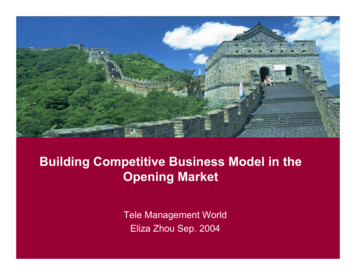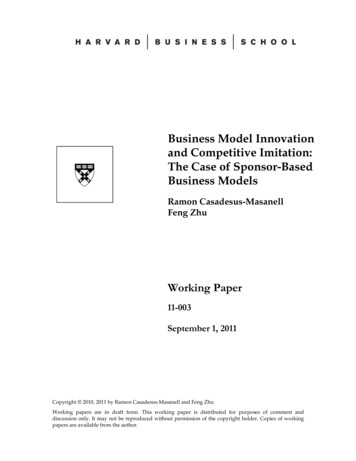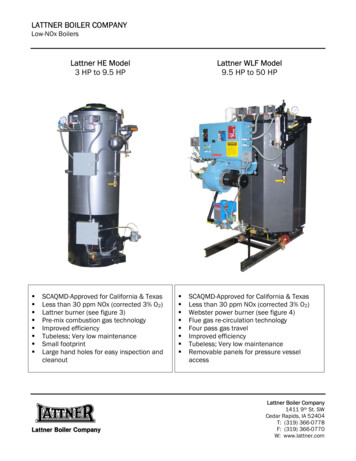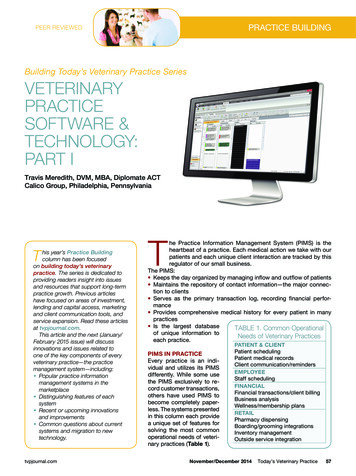
Transcription
Building Competitive Business Model in theOpening MarketTele Management WorldEliza Zhou Sep. 2004
Agenda China Communication Market Overview The challenges of China Operators– Business Process Reengineering– Enterprise IT planning– Make v.s Buy How to use IT to enhance the competitivebusiness model2
China operator is not far way fromleading operatorAverage User Value( )3,500Global leaderLeaderTelstraItalian telecom3,000?2,500?Market Value 100BNew ZealandTelecom2,000Leader?Market Vaule 50BPCCW1,000SKT?SBCMarket Value 10B1,500What is the keysuccessfulfactor becominga leader?Swiss TelecomBTVodaphoneBellsouthSpain telecomDeutsch TelecomNetherlandsTelecomFrance TelecomNTT500China TelecomChina Mobile(HK)China UnicomATTChallenger- Data Source: ge scale ,000180,000,000Total subscribers3
China’s telecommunication industry incomeexceeds 33.9B in 1st half 2004, growing 13%Chinese Telecommunications Market801st half of 20004 Summary70 Revenue CAGR of 13%- Mobile: 13.8%- POST: 5.9%Revenue ( B/yr)6050 Wireless Subscribers: 310M, grow14%.403020Paging1002000 Still exists huge diversity in largeprovinces and the west south China.The developed province is doublerevenue of the developing province.Mobile200120022003Yeardata source : MII200420052006Other Fixed LineInternationalDLDLocal4
Agenda China Communication Market Overview The challenges of China Carriers– Business Process Reengineering– Enterprise IT planning– Make v.s Buy How to use IT to enhance the competitivebusiness model5
These carriers face challenges which will drivedemand for IT servicesKey Challenges Facing Chinese Carriers In order to access capital markets (and/or IPO), carriers are seeking to demonstrate improved businessperformance– Extreme growth is no longer a given– Need new services, cost-improvement opportunities Carriers struggling to identify, attract, and retain high-end users– Wireless carriers facing decreasing average revenue per user (ARPU), focusing on mobile applications– All carriers struggling to unlock enterprise market, increase differentiation between consumer and business offerings– Focusing on enhanced customer care, CRM, DSS ability Increasing competition– China Telecom broken up into 2 separate, full-service carriers in 2003.– New licensees expected (3G in both wireless and wire line)– WTO will bring foreign entrants Carriers looking to consolidate vendors around higher quality solutions– Currently many small vendors with incomplete solutions Decision-making continues to be largely at provincial level, but will likely evolve to a more centralized model tocapture economies of scale– Key eastern provinces lead, others follow– China Mobile, Unicom have mix of central/provincial decision-making– Challenge is realizing benefits of centralization while preserving ability of provinces to react quickly6
Challenge 1 - Business Process isbehind the system buildingCurrent Market Position &environment : Business process is changingevery day. Lack of competitionexperience.Key Business Challenges: Looking for method and tools to improving process, preferredcustomer oriented marketing and sales process. Urgently to enhance the business intelligent capability, to supportthe time to market decision. standardize cross area and cross organization process to achieveeconomies of scale benefit Legacy systems built up forsupport basic product, notcomplicated services andproduct bundling. Provinces requirement isdiversified, cause theconfliction in headquarter andprovinces carrier.Recent Moves : Headquarter is planning to cooperate with consulting firms to start thepilot of new business process execution. Trying to consolidate the standard customer services process indifferent regions and define the KPI of each process. Build and optimize the business intelligent system to support decisionmaking.7
Challenge 2 - Enterprise IT strategy andplanning need evolutionary improvement.Enterprise IT architect is in high priority.Current Market Position &Environment : Over 80% IT system was builtby local system integrators. Each province level operatoris dealing with 30-40 smalland mid size systemintegrators. No well defined datamodeling, and one carrier hasdifferent versions for sameapplication. IT organization function isdecentralized and shared bybusiness department and ITdepartment Start enterprise IT strategyand planning one year ago.Key Business Challenges: Looking for strategy to have global leading IT company and local SIwork together, serving operators from business planning to solutionroll out. Define the well-planed data model base on across provincesbusiness and different platform. Build 3G IT architect v.s 2/2.5G existing platform.Recent Moves : Start to evaluate and downsize the small and mid size localvendors. More and more focus on IT long term planning, and start thetrail run in 2-3 selected provinces before national roll out. Keep building BSS/OSS system followed with well defineddata model and EAI consolidation roadmap. Evaluate the services cost v.s. h/w and s/w, thinking aboutoutsourcing strategy. Build up the carrier own knowledge management system.8
Challenge 3 – Build v.s. BuyCurrent Market Position &Facts : Heavily reply on existinglocal IT vendor howeversupported by nonreasonable servicesbudget. Facing the local IT vendorturn over risk. Culture confliction betweenpackaged s/w and clientcurrent business process Different businessscenario make the pkg. s/wlow efficiency, still existingmuch customerlizationworkload.Key Business Challenges: Lack of pkg. application production selection experience. To avoid decision risk, the carrier need long time decision cycle,which extended SI and S/W vendor longer time selling cycle. Data model is difficult matching pkg. S/W Lack of local SI drop-off strategyRecent Moves : Plan to evaluate pkg. s/w , and consider to implement pkg.s/w to take place of local developed application. Involve consulting firm to assess business process andcapability. Team up the local SI with global SI, trying to work out the costeffective vendor strategy. Start to prepare for 3G BSS/OSS operation.9
Agenda China Communication Market Overview The challenges of China Carriers– Business Process Reengineering– Enterprise IT planning– Make v.s Buy How to use IT to enhance the competitivebusiness model10
China telecommunication carriers ITstrategy evolution1997-1998 Mediation &Provisioning isupgraded from off lineto on-line, start to builddecentralized billingand settlement systemwith local SI. Achieve acrossprovinces connections.2000-2003 Start to buildconvergence billing andsettlement systems atprovincial centralizationto replace legacy citybase billing system. Start to build nationalwide roamingsettlement systemacross the differentcarriers and territories.2004-2005 Focus on BSS/OSSefficiency and flexibilitycapability enhancement Build up data servicesbilling system Define B/OSS KPI interms of infrastructureapplication and process Start 3G and 2/2.5GB/OSS consolidationplanning11
B/OSS drives competitive business model in the openingmarket B/OSS flexibility Real time billing Billing Accuracy IT KPI matrix build up9Support thousands product and servicesbundling, and reduce time to market. Eachnew product roll out only need 5 days,especially in China wireless competition, eachprovinces has almost 2000-5000 services andproduct bundling options.9Real time billing and invoice, full cycle fraudmanagement.9Double refund for error billing, miscalculatedinvoices.9Business department lead the customersatisfaction KPI to measure the IT andsupporting department performance.12
KPI about China one wireless operatorTime to upgrade the existing billingsystem: Rate Adjustment Invoice Format and Alternative Pricing Structure Response to new business客户Source from A.T.Keaney 2003Supportedbundle imited2000-60001000-2000500-10000-500Provincial operators market 用行为属性账户付费行为属性13
B/OSS is the strategic competence of marketingand salesComprehensiveB/OSS BASSBOSSBASS¾Build up key account team focus on national enterprise services¾Compete in high value customer retention¾Cost effective strategy to increase ARPUNational DSSNation billing &settlementHQNation billing &settlementNational B/OSSNational CRM National ERPNational B/OSSProvince DSSProvinceProvince BillingProvince B/OSSProvince call centerProvince Call CenterProvince B/OSSProvince B/OSS2002年2003年City level billingcitiesCity level Call Center2000年City level call center2001年14
China Telecom Carriers is going to move to leading markets andcompete with killer appsPlan to release Use killer appsSmallPersonalmultimedia Including ring tones, caller rings,livescreen Focusing on person-to-personexpression Including SMS, MMS andmessenger, etc. Focusing on person-toperson communicationMessagingScales ofbehaviorchange Official and unofficialwebsites, communityand public communication Focuses on information needswithout social involvementLargeInformation Including E-banking, e-commercial,mobile credit card, etc. Focuses on transactional needs,without social involvementSocial Direction ofevolutionCommunication RangeTransactionsPersonal15
China telecom operator is in the transformation to NGWS Servicesand Business ModelsThe NGWS services have been implemented in a variety of business modelsBusiness ModelsNGWS ServicesAccess &TransportProviderContent b SurfingData transferDigital goods purchasingSponsored Walled GardenPhysical goods purchasingLocation Based Service B2CLocation Based Service B2BCorporate Application16
Accenture provides China telecom operators with“customer feature IT architecture”, which helps clientto build leading servicesData Sources – Customer Channels (Internal, External, Supplychain) and Source Systems (Internal, External, Supply chain)Customer Identification Architecture – Customeridentification batch and/or real time modulesData Movement Architecture – An integration layer containingreal time messaging architecture and/or a batch populationarchitecture.Customer Repository – Physical Customer focused datastores: Customer ID DB, Profiles, DW, ODS, etc.Relationship Marketing Architecture – CampaignManagement, Content Management, Marketing Strategy andCoordinationCustomer Analytic Architecture – Data Mining (Modeling,segmentation), Reporting, OLAP, MetricsOperations Architecture - The Operations Architectureprovides the services to support the overall IVoC architecture,to ensure that all data is moved properly and in a timely mannerIt overlaps with many of the components found within the DataMovement Architecture.Development Architecture - The Development Architecture,while not really different for IVoC than for any other project, it istypically more complex due to multiple organizations andtechnical platforms touched and affected.17
Leading business model include 5 corecapability1.Customer Customerinteractivecapability2.Service andproduct bility18
Key Successful Factor for ChinaCarriers Culture transformation– Cooperation with global leading vendors and partners to build keybusiness process and IT system.– Local IT vendor recruitment and optimized strategy. Enterprise IT capability evolution– Evolution from pure customer built application to commercial S/W,enhance enterprise wide IT architecture framework.– IT capability and market & sales capability alignment Capital efficiency– Leverage capital market operation experience– Involved foreign operator to develop the international market19
THE ENDThank you!20
National DSS 2002年 . player Mobile Office Enabler Application Service Provider Payment Collector Web Surfing Data transfer Physical goods purchasing NGWS Services China telecom











